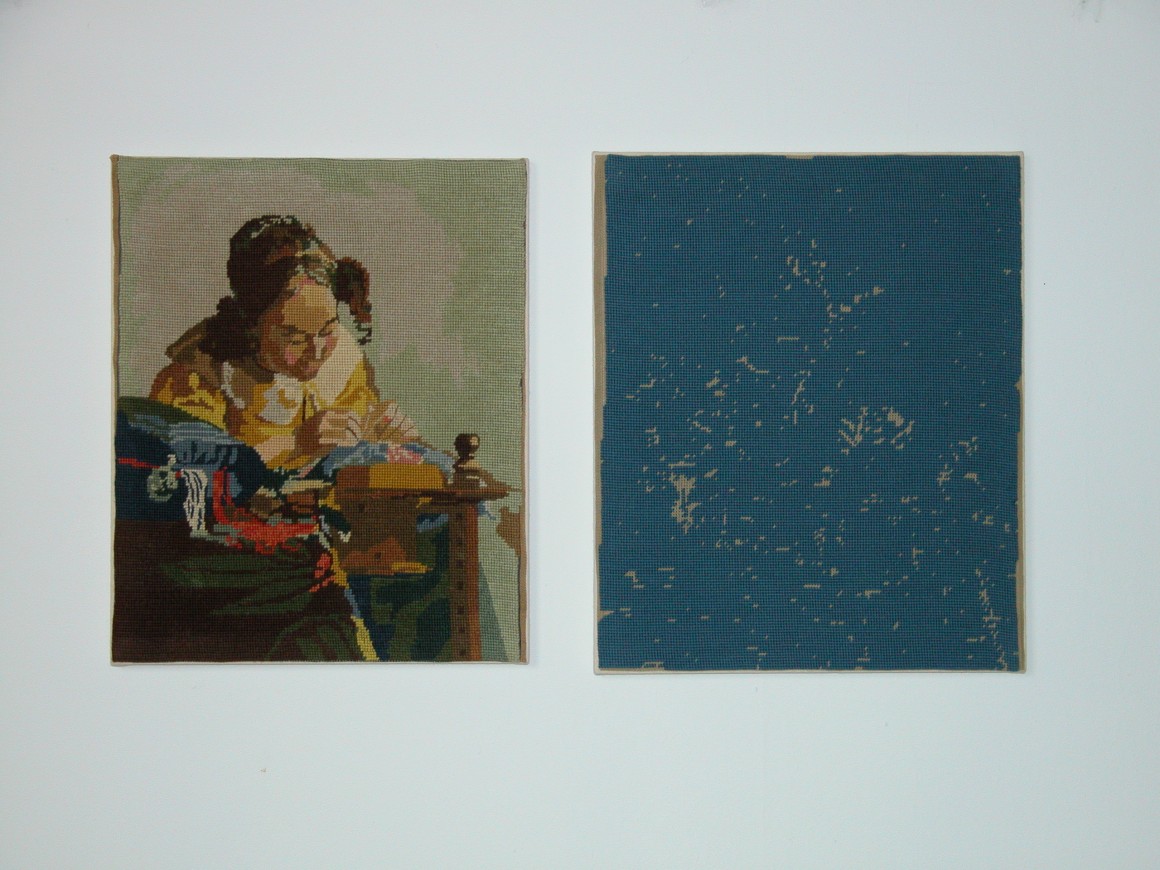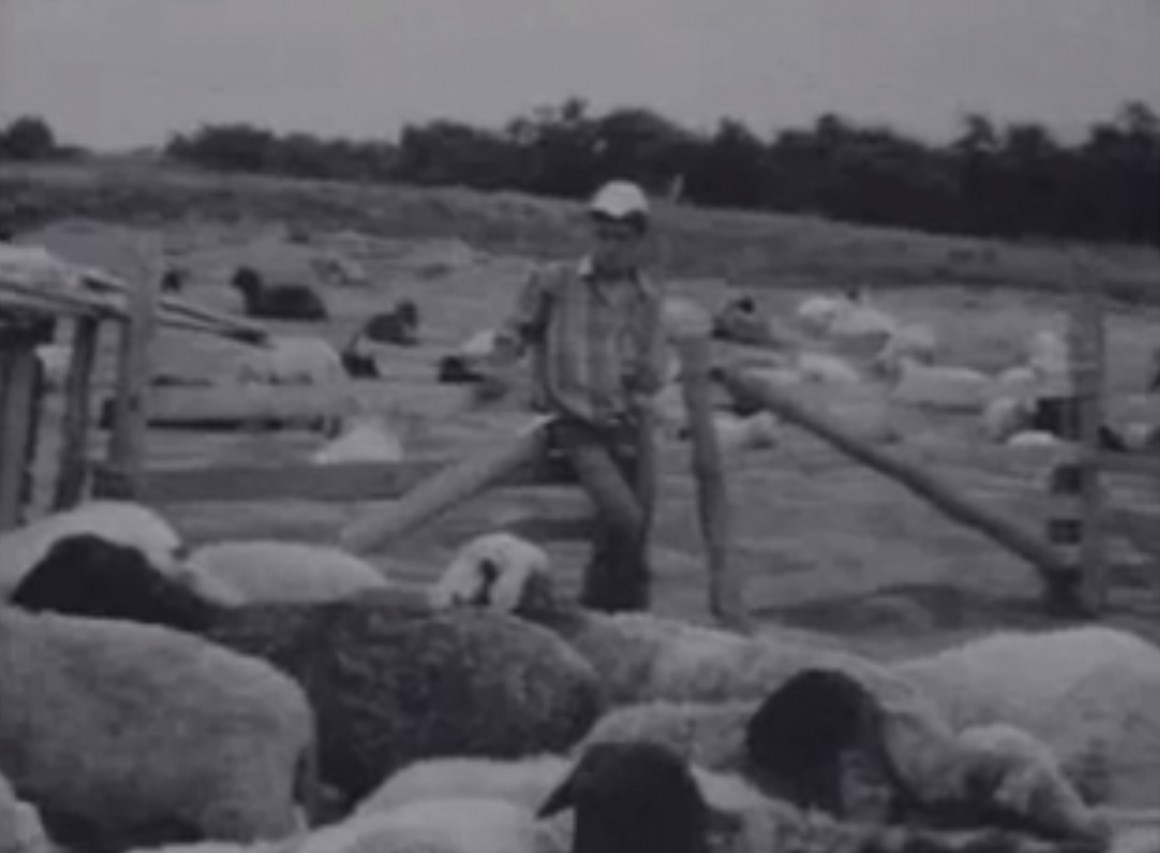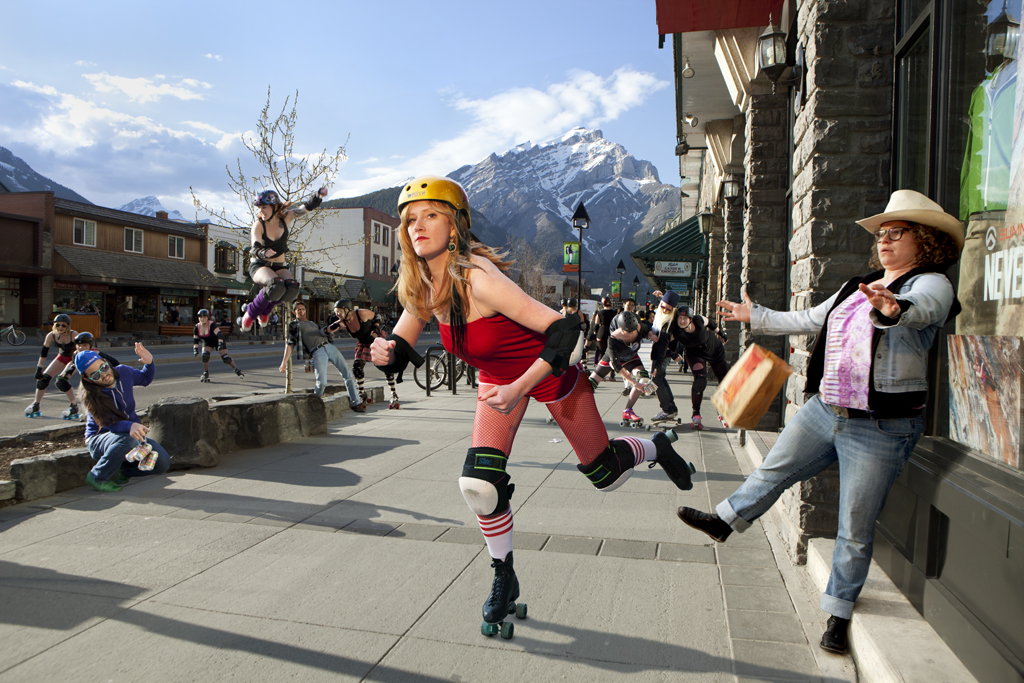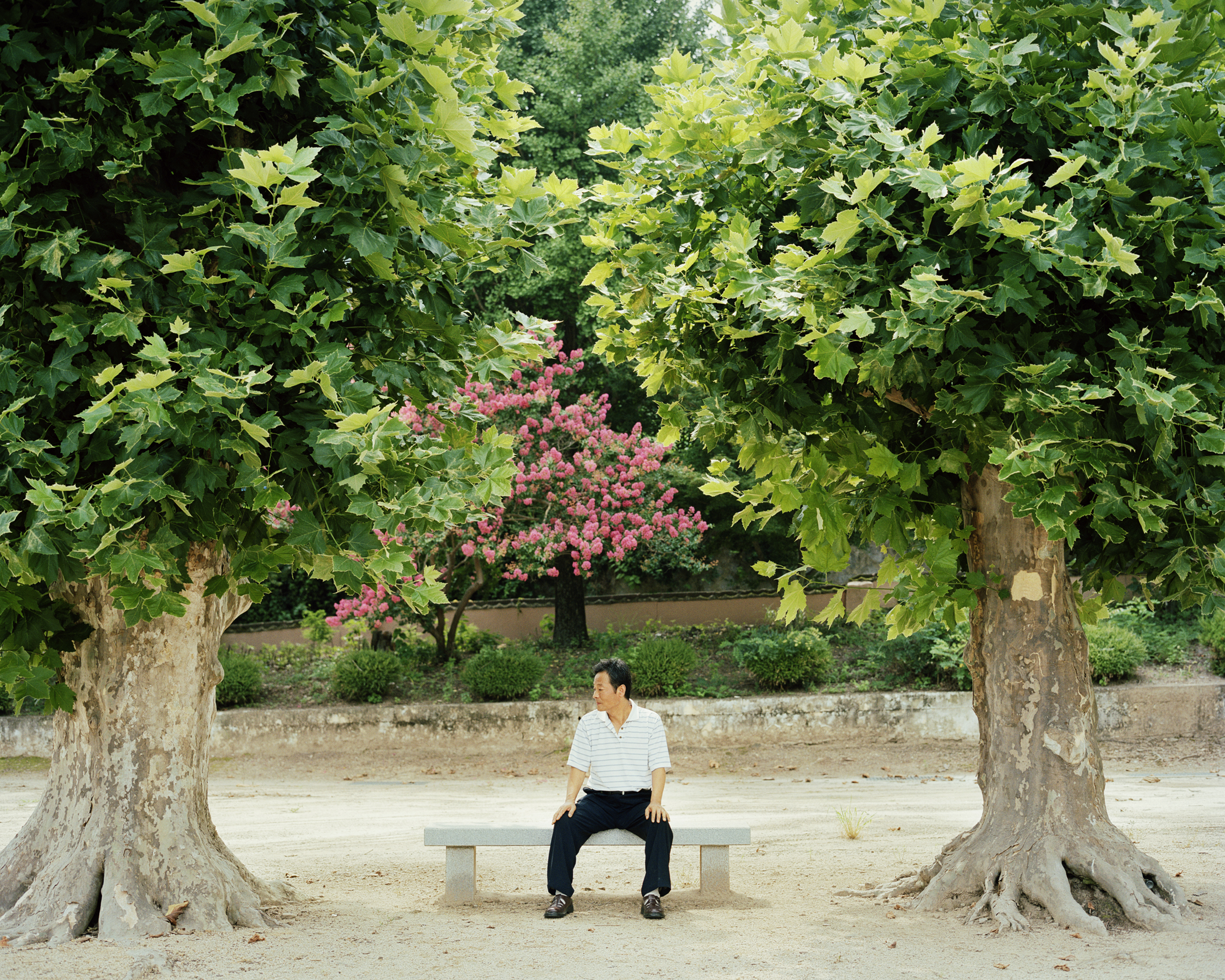IGNITION is an annual, curated exhibition presenting recent work by students in Concordia University’s graduate Studio Arts program and Humanities doctoral program. It provides an up-and-coming generation of artists with a unique opportunity to present ambitious, interdisciplinary works in the professional context of a gallery with a national and international profile. Students work directly with Gallery staff to produce an exhibition that places an emphasis on critical, innovative, and experimental work engaging in an exploration and consideration of diverse media and practices. This year, IGNITION features artists exploring a wide array of topics through an equally wide range of media—from painting, sculpture, and embroidery to photography, video, and installation.
Eugénie Cliche creates unconventional scenarios that walk the line between playful and disturbing in what she terms photobroderies where she embroiders over Photoshopped digital images of family members. In her photographic series, Bad Girls, Dayna Danger reworks archetypal female figures often linked to scandal and shame as empowered protagonists who boldly embrace their sexuality and stray from society’s mores. Rosika Desnoyers delves into the material history of needlepoint, looking at this often disregarded amateur art form that was once widely practiced by many European women.
Jinyoung Kim photographs her father’s return to South Korea after over a decade’s absence, posing him against various backdrops that subtly hint at the intensity of the experience. In his multifaceted project Kaval, Bogdan Stoica mines the traditional Eastern European flute as a complex metaphor for immigrant experience and cultural identity in flux.
Drawing from artist Robert Smithson’s text, “A Tour of the Monuments of Passaic, New Jersey,” about a trip taken from Manhattan to the suburbs in 1966, David Butler uses Google Street View to retrace this iconic voyage, morphing elements of time and space. Using the gaze as a focal point in her video, Outlook, Sandra Smirle explores the impact of mediated reality in an era of constant surveillance.
Andrea Szilasi juxtaposes photographs of weight-training equipment with paintings cut and pasted from Western art history books, generating unexpected environments from these differing aesthetics and forms. Véronique Chagnon-Côté builds on the landscape painting genre, depicting lush gardens and foliage that draw attention to the human desire to control and contain the natural world.
Produced with the support of the Frederick and Mary Kay Lowy Art Education Fund.
The Leonard & Bina Ellen Art Gallery is supported by the Canada Council for the Arts. The Gallery and the artists gratefully acknowledge Hexagram and CDA for their technical support.
The work featured in this edition of IGNITION was selected by jake moore, Director of the FOFA Gallery, and Michèle Thériault, Director of the Ellen Art Gallery.
Artists
David Butler is a Montreal based artist, having relocated from Ontario in 1994. Current an MFA Sculpture candidate, his multidisciplinary practice draws on past studies in linguistics, art history, and photography. Recent work has been shown at the Canadian Centre for Architecture, Galerie Lilian Rodriguez, and Art Souterrain.
Taking the ruin as theme, David Butler explores material culture as it is transformed by emerging digital technologies. Drawing on the methodologies of architecture, museology, and archaeology, his work examines the impact of digitization on our understanding of history and how we relate to the physical world around us.
THE WORK
The Dead Man Drifted Along in the Breeze, 2013
Video, 11 min.
The Dead Man Drifted Along in the Breeze presents a re-performance of Robert Smithson’s walk, A Tour of the Monuments of Passaic, New Jersey through the technology of Google Street View; an uncanny landscape of stitched and stretched images with “lines the size of streets, and squares and blocks the size of buildings.”1
1 Robert Smithson, A Tour of the Monuments of Passaic, New Jersey, The Writings of Robert Smithson, ed. Nancy Holt, 1979 ed. (New York: New York University Press, 1979) 56.
EXPLORE
- the ways in which this work addresses the work of artist Robert Smithson;
- the origin and status of the image and why these are important considerations in this work..
ADDITIONAL SOURCES OF INFORMATION
David Butler, web site: www.davidbutlerworks.com
Véronique Chagnon-Côté lives and works in Montréal. She holds a BFA from UQAM (2009), and is currently an MFA candidate at Concordia University. Her work was presented in a solo exhibition at Galerie B-312 in 2011.
My paintings are an exploration of space where several pictorial elements are combined through the multiple layering of matter. This paint is constructed: lines, tints, angles and vanishing points are superimposed to form imaginary spaces. They form obscure and utopian landscapes, at once interior and exterior, where nature meets structure, walls, and openness. Ideas of construction and deconstruction in painting, of multiple spaces and transformation, are themes that continually reoccur in my work.
THE WORKS
Les bois, 2013
Acrylic on canvas
Le feu, 2012
Acrylic on canvas
Feuillage II, 2012
Acrylic on canvas
Feuillage III, 2013
Acrylic on canvas
L’arbre, 2012
Acrylic on canvas
This series focuses on the idea of the garden as a site belonging to nature and to humans. The garden is a closed space, an arrangement, a structure where humans choose to organize nature. “… trees are cut along the edge of wild forests, they form a protective hedge that half belongs to the wilderness, and is already half way to taking on human form.” 1
1 Translation of an excerpt from Anne Cauquelin. L’invention du paysage. (Paris: PUF; Quadrige, 2000) 118.
EXPLORE
- how this work explores space and landscape;
- notions of construction and deconstruction.
ADDITIONAL SOURCES OF INFORMATION
Véronique Chagnon-Côté, web site: www.veroniquechagnoncote.com
Complot 7 : Déjà Vu. Montreal: Complot; UQÀM, 2010.
Delgado, Jérôme. Pièges et complots. Le Devoir, 13 Mar. 2010.
Eugénie Cliche lives and works in St-Lambert. To date, her video work has been presented in several galleries and festivals in Quebec and in Canada, as well as internationally in Europe, North Africa, Central and South America, and Asia. Eugénie Cliche is a co-founder and active member of the performance collective Les Fermières Obsédées, who have instilled a lack of discipline in the genre of action art since 2001. Cliche has received several grants from the Conseil des arts et des lettres du Québec and the Canada Council for the Arts.
For the past ten years, I have constructed a world of unrestrained imagery that merges performance, cinematography, photography and embroidery. Combining playfulness, the ridiculous, irony and pathos with violence, my work references cinematography as well as mass culture and collective memory. The subversion of these selected identities creates a stance that ensnares the viewer. This machination assimilates time and trends by conjuring stories behind the façade, and by showing the secrets behind the icon.
THE WORK
L’arche, 2012
Ten embroideries, cotton thread on linen
In the embroideries comprising the body of work entitled L’arche, a narrative takes place suggesting unusual stories of which the viewer becomes the author. These stories are inspired by the bonds of brotherhood, the hierarchy existing within a family, and individual personalities.
EXPLORE
- the ways in which the artist makes use of narrative;
- embroidery as a medium and how it contributes to the development of narrative in this work.
ADDITIONAL SOURCES OF INFORMATION
Eugénie Cliche, web site: www.eugeniecliche.com
Loubier, Patrice, and André-Louis Paré. La biennale de Québec : Manif d’art 3. Québec: Manifestation international d’art de Québec, 2008.
Ouellet, Geneviève, ed. Orange como como. Saint-Hyacinthe: Expression, Centre d’exposition de Saint-Hyacinthe, 2008.
Dayna Danger is an emerging artist who was raised in Winnipeg and is currently based in Montreal, where she is completing her MFA in Studio Arts at Concordia University. In 2010, she graduated from the University of Manitoba’s School of Fine Arts with a BFA (Honours). In 2011, Danger participated in the Aboriginal Studio Work Study Program in Visual Arts at the Banff Centre. In the winter of 2012, she participated in Trading Post, an Aboriginal residency program led by Candice Hopkins, also at the Banff Centre.
I work with digital photography, sculpture, installation, and performance to reinterpret history and traditions. My interests include patriarchy, feminism, religion, gender, fetishism, and animalia, among others. Digital photography informs my work. Through digital editing, I subvert the notion of truth in the photograph to create an alternative truth, a pluralistic female narrative. Ease of access to this medium affords me the opportunity to reinterpret the male dominated genres of historical painting and photography.
THE WORK
Bad Girls, 2009 – ongoing
The Outlander, 2011
Chromogenic print
Pandora, 2011
Chromogenic print
Derby Girls, 2011
Chromogenic print
My catholic upbringing has impressed upon me ideas about what acceptable women are, how they act, what they look like, and how they are portrayed. By referencing the Renaissance and the genre of history painting, I create mythological and allegorical images of women throughout history, with a rebellious, sexual twist. These women fascinate me because their stories cast them as “bad girls”. My images ask the viewer to consider why the women I portray might be perceived as “bad” or malfeasant? The use of allegorical stories and myths allow me to present archetypal female characters throughout history that advance a new historical image, one in which the female is empowered and in control.
EXPLORE
- the types of images that serve as references for this work;
- the kinds of questions that are raised about representation in this work and the ways in which they are raised.
ADDITIONAL SOURCES OF INFORMATION
Dayna Danger, web site: www.daynadanger.com
DiManno, Corrie. It’s Time to get Dangerous. Banff Crag and Canyon, 6 Jul. 2011.
Werier, Leah. So Bad, it’s Good. The Manitoban, 26 Jan. 2010.
Rosika Desnoyers is a university-trained visual artist with experience working in museums in Canada and in the US. In December she defended her thesis in the Humanities Doctoral Program and is now pursuing her art practice with post-doctoral research.
Interdisciplinary and developed within an art practice premised on the use and understanding of pictorial embroidery, my doctoral work investigates the emergence of Berlin work. This includes the creation of a micro-archive of research-related materials, artefacts and artworks. Doctoral work has been a means for me to develop an art practice that incorporates a reflexive critique of its own making and of the disciplinary regimes of contemporary research creation.
THE WORK
Excerpt from a micro-archive, c.1750 – the present
My thesis operates as a genealogical investigation of a specific cultural practice that is located in the interplay of various historical forces and that defines needlepoint as an object of discourse. It provides an unprecedented view of needlepoint as a practice suspended between historically specific and temporally sedimented disciplinary gazes. Excerpt from a micro-archive draws on my doctoral research.
EXPLORE
- the role that needlepoint plays in this work and how it is examined as a practice;
- the notion of the archive and how it functions in this work.
ADDITIONAL SOURCES OF INFORMATION
Léger, Marc James. Homo Academicus Curatorius: Millet Matrix as Intercultural Paradigm. On Curating. Web, forthcoming.
Léger, Marc James. An Interview with David Tomas Concerning his Recent Collaboration with Rosika Desnoyers, Part I. Etc , revue de l’art actuel 93 (2011) 42-46.
Tomas, David. Programming and Reprogramming Artworks: A Case of Painting and Practicing Conceptual and Media Art by Other Means. Intermédialités 13 (2009): 89-113.
Jinyoung Kim holds a BFA from OCAD University in Toronto and is currently a student in the MFA program at Concordia University. She has exhibited her work at the John B. Aird Gallery, Toronto, the Living Arts Centre, Mississauga, and at Les Territoires and Galerie Lilian Rodriguez in Montreal.
Kim uses her personal experience of immigration as a springboard for her artistic projects. Her works take various forms that articulate transformational processes relating to one’s identity and one’s relationship to society. She is interested in constructing a visual metaphor that both formally and conceptually resonates with emotional and psychological experience. She combines documentary with fiction in her photographic projects.
THE WORKS
The Fathers in Sanctuary, 2012
The Playground, 2012
Chromogenic print
The Playground II, 2012
Chromogenic print
Hibiscus and Bridge, 2012
Chromogenic print
The Fathers in Sanctuary tells a story of fatherhood, nuanced by the experiences of an emigrant. My father returned to South Korea briefly in the summer of 2011, to visit his parents and relatives for the first time since his emigration to Canada. I accompanied him in this reunion process. Every hour was intensely charged with emotion, expectation, and sense of absolution and yet each day passed like any other. I am interested in representing the significance of this particular experience over two generations of my father’s life, through portraits of him as the different men that he has been during my life, as well as the men he has been in the context of his place of birth, his psychological anchor.
Onion, 2013
Through the implied action of reconstructing an onion, by stitching the unravelled skins back together, Onion addresses the mourning of loss and the process of rejuvenation.
EXPLORE
- the artist’s investigation of the relationship between immigration and identity;
- the visual language used by this artist.
ADDITIONAL SOURCES OF INFORMATION
Jinyoung Kim, web site: www.jinyoungkim.net
Clément, Éric. Le corps et le paysage: les lentilles de Concordia. La Presse 30 Mar. 2013.
After earning her BFA from Concordia University, Sandra Smirle returned to her native Toronto to pursue a mixed media art practice. Since then, whether in Paris or ‘off the grid’ on Canada’s west coast, she has consistently worked on new and increasingly ambitious projects. Her work has been included in solo and group exhibitions and has been acquired by private and corporate collections in Canada, as well as in Australia and Europe. Smirle’s work is included in The Map as Art: Contemporary Artists Explore Cartography (Princeton Architectural Press, 2009).
My current work builds on ideas around surveillance, dataveillance and a ‘viewer society’, in which fear of the loss of personal privacy articulates with perceptions of enhanced security. Public and participatory surveillance — less technology, more a way of seeing — within our everyday contemporary culture can render the consumable controllable and the protective empowering.
THE WORK
Outlook, 2012
Video, 26 min. 13 sec.
Outlook is a 25-minute video document: the mapping of an intersection in my daughter’s life at age ten. It is composed of five separate video portraits. For each of these, M sat for two five-minute periods, alone in a room with a timer, once being watched by the camera and then again while watching the live feed. The result is an interplay of conscious and unconscious, a dialogue with herself, simultaneously seeing and being seen.
EXPLORE
- the various elements that constitute this work and the roles that each one of them plays;
- notions of the gaze and the ways in which they are embodied in this work.
ADDITIONAL SOURCES OF INFORMATION
Sandra Smirle, web site: www.sandrasmirle.com
Vaughan, RM. St. Jamestown without stereotypes. What a relief. The Globe and Mail, 27 Nov. 2010.
Whyte, Murray. View from above: Sandra Smirle’s Like/Unlike at Loop. The Toronto Star, 24 Mar. 2011.
Bogdan Stoica holds a BFA in Film Production and Photography from Concordia University, where he is also currently enrolled in the MFA program (Photography). His work has been exhibited in Romania and Canada in both group and solo exhibitions.
Bogdan Stoica’s work focuses primarily on questions of cultural change and the inevitable losses experienced in one’s identity when one’s environment is transformed. Stoica’s work deals with both the desire to extract oneself from one’s actual cultural situation, and also with the inability of certain cultural elements to resist change.
THE WORK
Kaval, 2012 – 2013
Untitled, 2012
Untitled, 2012
Untitled, 2012
Untitled, 2012
Untitled, 2012
Inkjet prints
Untitled, 2012-2013
Untitled, 2012-2013
Wood
Five Songs for Kaval, 2012 – 2013
Audio recording, 10 min.
Shepherd, 2008
Video, 2 min. 30 sec.
The project Kaval is an “ode” to a nearly extinct musical instrument, an ancient shepherd flute. For the past two thousand years, the instrument has traveled from Asia to Eastern Europe and has adapted to the multitude of cultures that embraced it. Through photography, video, and sound, its universe has been reinterpreted once more.
EXPLORE
- cultural identity and its evolution and how reference is made to these in this work;
- sound and its contribution to Kaval.
ADDITIONAL SOURCES OF INFORMATION
Bogdan Stoica, web site: bogdanstoica.com
Andrea Szilasi lives and works in Montreal. After receiving a BA in Cinema Studies and French Language and Literature from the University of Toronto, she returned to Montreal and obtained a BFA from Concordia University. She is presently pursuing graduate studies in Photography at Concordia University. Her work has been exhibited in solo and group exhibitions across Canada, in Mexico, and in Europe. Her work is included in the collections of the Canadian Museum of Contemporary Photography, the Musée national des beaux-arts du Québec and private collections. Andrea Szilasi is represented by Joyce Yahouda Gallery.
I am fascinated by the representation of the human body in the photographic medium. In particular how our interpretation of a human being is constituted by the formal conventions inherent to each genre of representation. I alternate between taking my own photographs and making collages using found images. Over the years I have made collages that recombine images from a range of sources so as to “make strange” the original meaning of the photograph. I have explored genres ranging from dramatically lit black and white 1950’s studio portraits to warm-toned, soft-focus, colour centerfolds.
THE WORKS
Squat Cage (black and white), 2013
Digital print, paper, Polaroid photograph
StairMaster, 2013
Digital print, page from book
Squat Cage (with Vasarely and opera), 2013
Digital print, page from book
For IGNITION I am presenting three recent collages that combine photographs of Atlantis weight training equipment with small photos, collages, and found images from art history books. I am working with the machines as geometric forms that encase or support a figure carrying out a mechanical motion. The rudimentary collage technique that I employ calls attention to the photograph as a material object and to the deliberate joining of unrelated worlds.
EXPLORE
- representation and the human body and the ways in which this work explores these;
- this artist’s use of collage and found imagery.
ADDITIONAL SOURCES OF INFORMATION
Landry, Pierre. L’éclatement des frontières, 1965-2000. Femmes artistes du XXe siècle au Québec.
Ed. Esther Trépanier. Québec: Musée national des beaux-arts du Québec, 2010.
Lamarche, Bernard. Familiarités déboussolées. Le Devoir. 9 Aug. 2003.
Dagenais, Francine. Andrea Szilasi. CV Photo 44 (1998): 15-21.


















